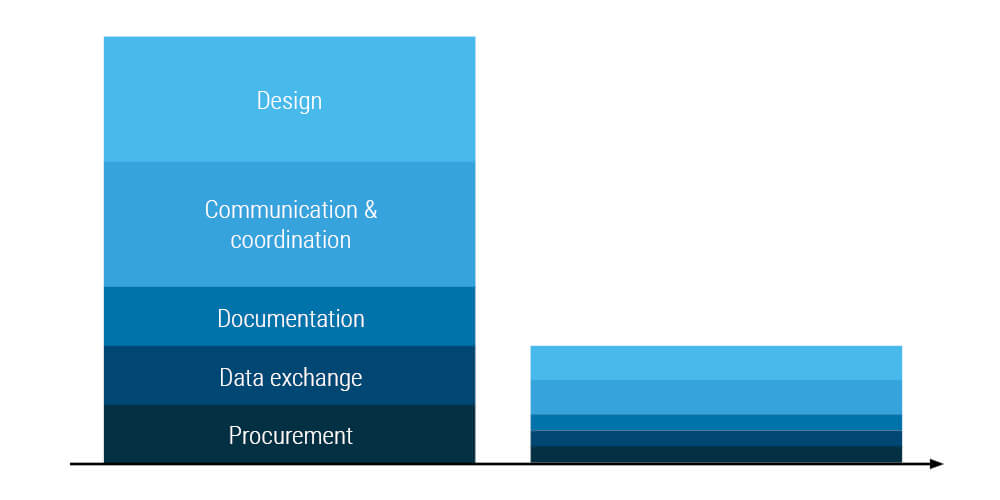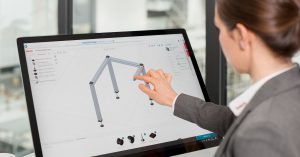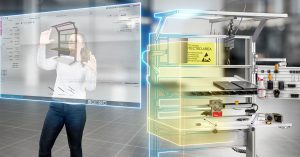
From design to coordination – how the potential of digitalisation simplifies the planning of ergonomic work benches in industry.
It is often said that, when it comes to the holy trinity of quality, time and cost, the best you can do is two out of three. Christian Thiel, item expert for digitalisation and design, disagrees: “With all due respect, that’s not right. I prefer a solution that rises to a challenge so definitively and effectively that you wonder why you put up with the old solution for so long.” This is the principle behind both our building kit system approach and our online tools, including the Work Bench Configurator. This assembly work bench planning tool enables users to design a customised work bench in 3D through a simple drag and drop process directly in their browser. They benefit from a whole range of time-saving functions, even when it comes to documentation and coordination. In this interview, Christian Thiel explains exactly how the Work Bench Configurator speeds up work bench planning processes.

Configure industrial work benches online
Discover what the Work Bench Configurator with its 3D view and smart functions can do. Simply put together your own custom work bench for manual assembly operations in your web browser or use the tool with Halocline software and explore virtual reality design techniques with a VR headset.
FIND OUT MORE
Time-consuming aspects of conventional planning
Why is planning an assembly work bench in the conventional way such a complex process?
Well, first of all, you have to keep one eye on the big picture, and that goes far beyond merely the design work. We have identified a total of five areas involved in the typical planning process – design, communication/coordination, documentation, data sharing and procurement. Of course, the work involved is not spread evenly across these areas, but it does add up to quite a lot. And there is potential for optimisation at each point in the assembly work bench planning process.
When it comes to documentation, for example, the main thing is to answer questions about the design once it has been completed – what is the parts list like, for instance. Then you have to find the correct contact person at your supplier. Vital to this, of course, are aspects such as costings, delivery times and binding obligations.
What other obstacles are there?
It’s a similar picture when it comes to data sharing. Imagine you’ve created something in a CAD system, for example. You then have to export the drawing or the STEP data. But the recipient still has to receive this data – and there are often several technical obstacles in the way of this.
Then there’s coordination. Let’s say I just have a simple sketch – basic, but understandable for someone with a technical mindset. Although I may have saved time on the design stage, if I then have to coordinate with someone who is less technically minded, that can end up taking a lot of time and effort. Even placing an order is difficult, since there is no parts list, and the design is tricky to reproduce.
However, if I invest a lot more time and use a CAD system for the design and create a drawing there, I will have documentation afterward that is good – or at least acceptable. This in turn makes coordination easier. It’s a huge amount of work, though.

Considerable time savings in assembly work bench planning
Can you be more specific about how the Work Bench Configurator simplifies the planning of an assembly work bench?
I’m not saying we’ve eliminated all the complexity in the areas I mentioned. However, the possibilities offered by the Work Bench Configurator cut it back immensely. The outlay is much lower – particularly at the most work-intensive points.
It all starts with a special filter in the Work Bench Configurator that is completely focused on the customer’s needs. Users are asked directly what they require. That might be, for example, whether they’re interested in the maximum load-carrying capacity or would like an electric or manual height-adjustment system. This also makes communication with colleagues a lot easier. Right at the start of the design process, you can sort out questions such as, “What load-carrying capacity do we need again?”
The filters for load-carrying capacity or whether the height adjustment should be electric or manual make it much easier to communicate with colleagues.
The configurator also takes account of the key factor of ESD safety. For example, it asks users who are wanting to plan an assembly work bench whether or not their work bench needs ESD protection. Answering in the affirmative activates a particular highlight of the tool – the electrostatic protected area (EPA). If a component that is not ESD-safe is placed within the EPA, it is highlighted in yellow as a warning.
In what way is design work made easier?
Within the working area, you can zoom in and out, move elements around freely and drag and drop components. This means you can see your configuration immediately – in 3D – and whether it works for everyone involved. It also offers the perfect basis for discussions, because it is such a clear illustration.
On top of that, there is the considerable time saving during configuration. If I want, say, a Strut Set, I just drag it onto the work area – and the tool shows me where I can place it, directly in the right position and the right width. I can define the position with millimetre accuracy, adjust the height, and even add accessory components, such as those from our ergologistic® portfolio, which combines ergonomics with intralogistics.
As a result, I can quickly and easily plan and kit out my ergonomic work bench from top to bottom. The Work Bench Configurator is also smart and saves users a lot of work thanks to its intelligent automated processes. Even the high level of stability on the work bench is ensured in relation to its size, with supporting profiles automatically adjusted to a larger cross-section as required. Documentation is also generated automatically at the click of a button, and can be shared very easily.
Digitalisation opens up new opportunities
Are there also any new opportunities when it comes to the dimensions of the work benches?
item has always been famous for delivering made-to-measure solutions – after all, profiles of exactly the right length are at the heart of what we do. Now we are also extending this advantage to our standardised system work benches.
Since we are intently focused on the benefits to the customer and eager to get the most out of digitalisation, you can now choose between a standard size or a custom bench width. The bench can be steplessly set to the exact width needed for the application.
As a result, customers can now get a customised, unique piece for the price of a standard solution. From their perspective, there’s no difference between requesting a standard-size bench or ordering one in exactly the right size because, thanks to digitalisation, we have been able to optimise our processes to ensure our customers always benefit from the fastest delivery time.
We offer our customers the best delivery times for all benches, even custom-made solutions.
There is therefore no downside for customers. They save time and money because they no longer need any additional engineering services to customise the bench width. We offer our customers the best delivery times for all benches, even custom-made solutions.
What kind of role will virtual reality play in the planning of assembly work benches?
Virtual reality is a very exciting and relevant subject. We are working with our cooperation partner Halocline in this regard. Just imagine – in the future, someone could plan a virtual work bench in the Work Bench Configurator and then integrate it into a virtual-reality simulation of their production facility.
During this simulation, the actual users can make sure that their requirements have been met in terms of ergonomics, material supply and tool stowage – all without anyone having to build a cardboard model beforehand. This is also known as “virtual cardboard engineering”. Modifications and corrections can be made considerably faster and more cheaply as a result.
Benefits for assembly work bench planning at a glance
How would you sum up the benefits of the Work Bench Configurator?
Ultimately, there are four benefits that make the Work Bench Configurator stand out.
- 1. Simple: The Work Bench Configurator makes planning an assembly work bench easier by always asking the right questions and quickly and reliably guiding users to where they want to go.
- 2. Dependable: Defining and visualising the EPA ensures you can always see where the non-dissipative products are. The automatic placement of accessories ensures nothing is forgotten.
- 3. Collaborative: The 3D interface makes coordination and collaborative working much easier and more direct, based on the principle of “what you see is what you get”. There is no need to send huge volumes of data back and forth, either. Instead, users can simply share a link to the project and everyone involved has the data.
- 4. Fast: The opportunities offered by digitalisation make the entire planning process for assembly work benches much shorter for users. item benefits from this, too, since we – the supplier – can offer customised solutions with really short delivery times.





